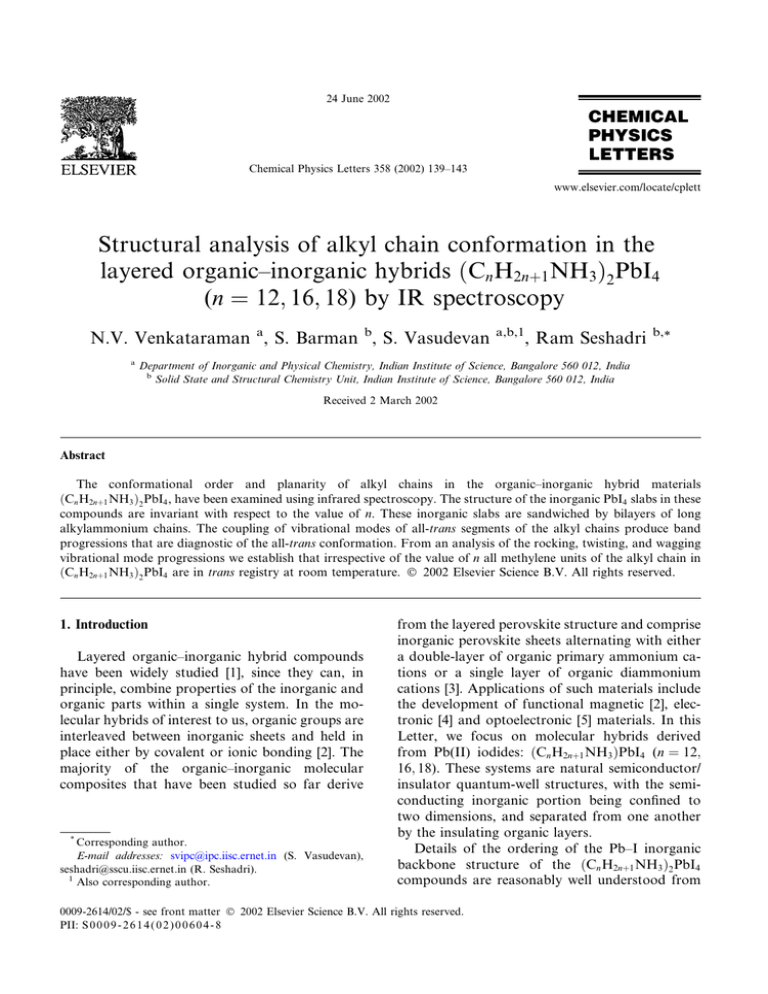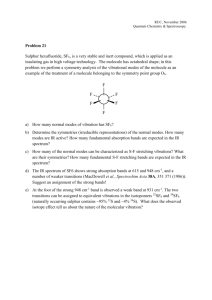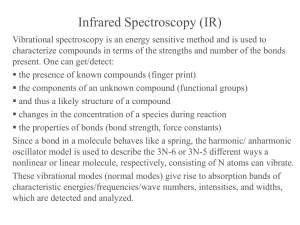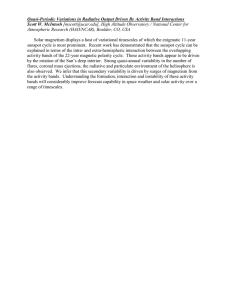
24 June 2002
Chemical Physics Letters 358 (2002) 139–143
www.elsevier.com/locate/cplett
Structural analysis of alkyl chain conformation in the
layered organic–inorganic hybrids ðCnH2nþ1NH3Þ2PbI4
(n ¼ 12; 16; 18) by IR spectroscopy
N.V. Venkataraman a, S. Barman b, S. Vasudevan
a
a,b,1
, Ram Seshadri
b,*
Department of Inorganic and Physical Chemistry, Indian Institute of Science, Bangalore 560 012, India
b
Solid State and Structural Chemistry Unit, Indian Institute of Science, Bangalore 560 012, India
Received 2 March 2002
Abstract
The conformational order and planarity of alkyl chains in the organic–inorganic hybrid materials
ðCn H2nþ1 NH3 Þ2 PbI4 , have been examined using infrared spectroscopy. The structure of the inorganic PbI4 slabs in these
compounds are invariant with respect to the value of n. These inorganic slabs are sandwiched by bilayers of long
alkylammonium chains. The coupling of vibrational modes of all-trans segments of the alkyl chains produce band
progressions that are diagnostic of the all-trans conformation. From an analysis of the rocking, twisting, and wagging
vibrational mode progressions we establish that irrespective of the value of n all methylene units of the alkyl chain in
ðCn H2nþ1 NH3 Þ2 PbI4 are in trans registry at room temperature. Ó 2002 Elsevier Science B.V. All rights reserved.
1. Introduction
Layered organic–inorganic hybrid compounds
have been widely studied [1], since they can, in
principle, combine properties of the inorganic and
organic parts within a single system. In the molecular hybrids of interest to us, organic groups are
interleaved between inorganic sheets and held in
place either by covalent or ionic bonding [2]. The
majority of the organic–inorganic molecular
composites that have been studied so far derive
*
Corresponding author.
E-mail addresses: svipc@ipc.iisc.ernet.in (S. Vasudevan),
seshadri@sscu.iisc.ernet.in (R. Seshadri).
1
Also corresponding author.
from the layered perovskite structure and comprise
inorganic perovskite sheets alternating with either
a double-layer of organic primary ammonium cations or a single layer of organic diammonium
cations [3]. Applications of such materials include
the development of functional magnetic [2], electronic [4] and optoelectronic [5] materials. In this
Letter, we focus on molecular hybrids derived
from Pb(II) iodides: ðCn H2nþ1 NH3 ÞPbI4 (n ¼ 12;
16; 18). These systems are natural semiconductor/
insulator quantum-well structures, with the semiconducting inorganic portion being confined to
two dimensions, and separated from one another
by the insulating organic layers.
Details of the ordering of the Pb–I inorganic
backbone structure of the ðCn H2nþ1 NH3 Þ2 PbI4
compounds are reasonably well understood from
0009-2614/02/$ - see front matter Ó 2002 Elsevier Science B.V. All rights reserved.
PII: S 0 0 0 9 - 2 6 1 4 ( 0 2 ) 0 0 6 0 4 - 8
140
N.V. Venkataraman et al. / Chemical Physics Letters 358 (2002) 139–143
X-ray diffraction measurements [6]. Local structural information on the molecular conformation of
the alkyl chains, and especially for larger n, are
however not available. Preliminary studies have
established that in these compounds the alkyl chains
adopt an essentially all trans conformation and are
tilted away from the interlayer normal by an angle
of 55° [7]. This has been arrived at from the variation
of the interlayer spacing as a function of interlayer
spacing and also from the orientation dependence of
the infrared spectra. We are attracted to infrared
spectroscopy to characterize alkyl chain conformation in these hybrids because of its effectiveness
in determining low concentrations of disorder
(gauche conformers) in an otherwise ordered system. On the other hand, diffraction studies of a
system that comprised, for example, 95% trans
chains and 5% chains with gauche defects, would
reveal the presence of such disorder only through
poor thermal parameters. Any sort of quantification of disorder would be difficult to achieve
through an average probe such as X-ray diffraction.
This problem is overcome through the use of a local
probe such as vibrational spectroscopy.
The method used here depends on the variation
of frequencies of the methylene wagging and
rocking–twisting modes with chain conformation.
It is well known that these vibrational modes in the
IR spectra of ordered alkyl chains may be described
as coupled oscillators, which produce band progressions diagnostic of the all-trans conformation
[8,9]. Modes of all methylene units in trans registry
are equally involved in giving rise to a progression
of regularly spaced modes corresponding to
standing waves extending over all contributing
methylene units. The observed frequency pattern is
characteristic of the number of CH2 groups in trans
registry. Structural applications of these modes
have been reported for the characterization of lipid
bilayers [10], gels [11], triglycerols [13], and intercalated surfactant bilayers [12].
2. Background on progression bands of the alkyl
chain
The delocalized vibrational modes of long chain
molecules have been interpreted on the basis of
vibrational modes of an infinite polymethylene
chain [14]. Conformational order within the alkyl
chains causes a coupling of the methylene vibrational modes and the resulting vibrational spectra
can be analyzed based on dispersion curves by
plotting the frequencies m as a function of the
phase angle / between neighboring methylene
units [8,9]. These dispersions have been compared
with the theoretical dispersion curves for methylene vibrational modes obtained by a normal coordinate analysis of an infinite polymethylene
chain. For an infinite polymethylene chain, only
vibrational modes at / ¼ 0 or p are infrared and/
or Raman active. In the case of a finite chain, in
addition to the / ¼ 0 or p mode, a series of bands,
namely progression bands, appear in the IR and/or
Raman spectrum. These bands have been studied
for n-alkanes [8,9], n-alcohols [15] and fatty acids
[16]. Progression bands are usually weak in intensity. However, it has been pointed out that end
group substitution usually enhances the intensity
of these progression bands as compared to the
crystalline n-alkanes [11].
Vibrational modes in an all-trans methylene
chain are described through a coupled oscillator
model for which the eigenvalues of the vibrational
secular equation are given by [8]:
X
4p2 m2 ¼ H0 þ 2
Hm ðcos m/k Þ;
ð1Þ
where H0 and Hm are the matrix elements of the
secular determinant. / are the phase differences
between adjacent oscillators as given by:
/k ¼ kp=ðN þ 1Þ
ðk ¼ 1; 2; 3; . . . ; N Þ;
ð2Þ
where N is the number of oscillators in the chain,
which in this instance is the number of methylene
units of the alkyl chain which are in trans registry.
The progression bands appearing in the spectrum
are analyzed by assigning a k value after identifying the particular mode to which it belongs.
When correctly assigned a smooth curve results
from a plot of mk vs. /k . The m3 and m4 modes arise
from CH2 wagging and C–C stretching modes,
respectively, of the methylene chain. In the m7 and
m8 modes coupling between the rocking and
twisting modes occur. At / ¼ 0, the m7 modes is
pure rocking and m8 twisting. These modes for a
single methylene group are shown in Fig. 1. As
N.V. Venkataraman et al. / Chemical Physics Letters 358 (2002) 139–143
141
4. Results and discussion
Fig. 1. Wagging, twisting and rocking vibrational modes of an
isolated methylene unit.
the phase angle increases the mixing of rocking
and twisting occurs and finally at / ¼ p the assignment is reversed; m7 is pure twisting and m8
pure rocking. For the simplest possible chain
imaginable, identical harmonic oscillators with
nearest neighbor coupling, the integer k has a
well-defined meaning; it indicates the number of
antinodes in the standing wave associated with
each vibration. For terminally substituted alkyl
chains all integral values of k allowed by Eq. (2)
are observable [15].
Fig. 2 shows the low angle region of the X-ray
diffraction patterns of the ðCn H2nþ1 NH3 Þ2 PbI4
(n ¼ 12; 16; 18) compounds. Only 0 0 l lines are
observed due to the extremely high degree of preferred orientation arising from the manner in
which the sample was mounted. The 0 0 l reflections can be counted as corresponding to l ¼ 1;
2; 3; . . . ; or l ¼ 2; 4; 6; . . . We have chosen the latter based on the established structure of some
ðCn H2nþ1 NH3 Þ2 MX4 species [17]. We consider each
unit cell as stacking two PbI2
4 slabs and four alkyl
ammonium chains along the c direction. The interlayer spacing (c=2) for the n ¼ 12; 16 and 18
, respectively.
compounds are 25.2, 30.5 and 33.4 A
Fig. 3 shows the infrared spectra in the
1400–1150 cm1 region for the ½Cn H2nþ1 NH3 2 PbI4
(n ¼ 12; 16; 18) compounds. The intense band at
1375 cm1 is due to the umbrella inversion mode
of the terminal methyl groups. The remaining
bands in this region arise from the wagging (m3 )
and twisting–rocking (m7 ) progression bands from
all-trans segments of the ðCn H2nþ1 NH3 Þ2 PbI4
(n ¼ 12; 16; 18) compounds. It may be seen from
Fig. 3 that the number of progression bands
3. Experimental
ðCn H2nþ1 NH3 Þ2 PbI4 compounds were prepared
by mixing stoichiometric quantities of PbI2
and Cn H2nþ1 NH2 in hydroiodic acid and refluxing to obtain a clear yellow solution. The solution was then cooled slowly to precipitate the
ðCn H2nþ1 NH3 Þ2 PbI4 compounds. The compounds
were washed with distilled water till the filtrate
showed complete absence of acid. The chemical
composition of the organic part was established by
C, H, N analysis. (n ¼ 12: C – 26.63%; N – 2.56%;
H – 5.73%; n ¼ 16: C – 33.56%; N – 2.39%; H –
6.51%). Powder X-ray diffraction patterns were
recorded in the h 2h Bragg–Brentano geometry
on a Siemens D5005 diffractometer employing
CuKa radiation. FT–IR spectra of ðCn H2nþ1 NH3 Þ2
PbI4 compounds were recorded as a KBr pellet on
a Bruker IFS55 or a Perkin–Elmer spectrum 2000
spectrometer at 2 cm1 resolution.
Fig. 2. X-ray diffraction patterns showing the 0 0 l reflections of
ðCn H2nþ1 NH3 Þ2 PbI4 (n ¼ 12; 16; 18).
142
N.V. Venkataraman et al. / Chemical Physics Letters 358 (2002) 139–143
Fig. 3. Infrared spectra in the 1400–1100 cm1 region of
ðCn H2nþ1 NH3 Þ2 PbI4 (n ¼ 12; 16; 18).
Fig. 4. Infrared spectra in the 1100–700 cm1 region of
ðCn H2nþ1 NH3 Þ2 PbI4 (n ¼ 12; 16; 18).
observed increases with a corresponding decrease
in inter band separation as the alkyl chain length
increases. The twisting–rocking progression bands
(m7 ) are seen as weak shoulders to the m3 progression bands. These are more clearly seen for the
n ¼ 12 compound.
Infrared spectrum in the 1100–700 cm1 region
is shown in Fig. 4. The bands at 914 and 965 cm1
are due to the C–N stretching. The rocking–
twisting (m8 ) progression series as well as the C–C
stretching (m4 ) bands appear in this spectral region.
The m8 bands appearing below 900 cm1 are easily
identified since this region is relatively free of
Table 1
n ¼ 12
n ¼ 18
n ¼ 18
m
(cm1 )
Assignment
m
(cm1 )
Assignment
m
(cm1 )
Assignment
1327
1312
1292
1275
1265
1248
1237
1217
1205
1185
922
876
834
792
763
741
720
W6
W5
W4
T4
W3
T3
W2
T2
W1
T1
R3
R4
R5
R6
R7
R8
R10 , R11
1327
1313
1303
1285
1264
1249
1242
1226
1219
1204
1196
1183
927
886
859
825
793
766
755
737
720
W8
W7
W6
W5
W4
T4
W3
T3
W2
T2
W1
T1
R4
R5
R6
R7
R8
R9
R10
R11
R12 –R15
1328
1312
1304
1291
1284
1271
1254
1234
1213
1200
1193
946
881
852
822
792
768
757
742
720
W9
W8
W7
W6
T7
W5
W4
W3
W2
T2
W1
R4
R6
R7
R8
R9
R10
R11
R12
R13 –R17
N.V. Venkataraman et al. / Chemical Physics Letters 358 (2002) 139–143
interfering bands. In the region above 900 cm1
the presence of bands due to C–N stretching as
well the C–C stretching, the m4 progression, makes
identification of the individual m8 progression
bands difficult. The C–N stretching bands are also
known to shift the positions of the m8 progression
bands above 900 cm1 . A tentative assignment of
the m4 bands is shown in Fig. 4.
The m3 wagging progression, m8 rocking–twisting
progression and m7 twisting–rocking progression
series were analyzed by assigning appropriate k
values (Table 1) from a comparison with the reported values for crystalline n-alkanes. The frequencies of the progression bands were then
plotted as a function of /ð¼ kp=ðN þ 1ÞÞ. The
assignment of the progression bands is indicated in
Figs. 3 and 4. The bands are labeled by their k
value. For the m3 , m7 and m8 progression series, a
smooth dispersion curve was obtained only when
N, the number of oscillators in Eq. (2), was taken
to be equal to the number of methylene units in the
143
alkyl chains of ðCn H2nþ1 NH3 Þ2 PbI4 (n ¼ 12;
16; 18). The resulting dispersion for the n ¼ 12; 16
and 18 compounds is shown in Fig. 5. It may be
seen that for a particular mode all points lie on an
identical curve irrespective of the alkyl chain
length. The experimental dispersion curve for the
m3 , m7 , and m8 progressions in fact lie on the calculated dispersion curve (solid line in Fig. 5) for an
infinite polymethylene chain [8,14]. The dispersion
for m4 band is not indicated since there is ambiguity
in assignment of k values because of the degeneracy associated with this mode. The fact that the
experimental points lie on identical dispersion
curve is evidence for the validity of the assignments of k values and consequently of the choice
of N the number of coupled oscillators, in Eq. (2).
These results unequivocally establish that at room
temperature all methylene units, irrespective of the
alkyl chain length, are in trans registry and that the
alkyl chains in ðCn H2nþ1 NH3 Þ2 PbI4 (n ¼ 12; 16; 18)
adopt an all-trans planar conformation.
References
[1]
[2]
[3]
[4]
[5]
[6]
[7]
[8]
[9]
[10]
[11]
[12]
[13]
[14]
Fig. 5. Dispersion of the methylene wagging (m3 ), twisting–
rocking (m7 ) and rocking–twisting (m8 ) modes of
ðCn H2nþ1 NH3 Þ2 PbI4 (n ¼ 12; 16; 18). Solid lines are the calculated dispersion curves for an infinite polymethylene chain
[8,14]. Dotted line corresponds to the C–C stretching band
progression (m4 ) which is not analyzed here.
[15]
[16]
[17]
D.B. Mitzi, Prog. Inorg. Chem. 48 (1999) 1.
P. Day, Philos. Trans. R. Soc. London A 314 (1985) 145.
G.C. Papavassiliou, Prog. Solid State Chem. 25 (1997) 125.
C.R. Kagan, D.B. Mitzi, C.D. Dimitrakopoulos, Science
286 (1999) 945.
T. Kataoka, T. Kondo, R. Ito, S. Sasaki, K. Uchida,
N. Miura, Phys. B 201 (1994) 423.
D.B. Mitzi, Chem. Mater. 8 (1996) 761.
N.V. Venkataraman, S. Bhagyalakshmi, S. Vasudevan,
R. Seshadri (communicated).
R.G. Snyder, J.H. Schachtschneider, Spectrochim. Acta.
19 (1963) 85.
R.G. Snyder, J. Mol. Spectrosc. 4 (1960) 411.
L. Senak, D. Moore, R. Mendelsohn, J. Phys. Chem. 96
(1992) 2749.
W.H. Yan, H.L. Strauss, R.G. Snyder, J. Phys. Chem. 104
(2000) 4229.
N.V. Venkataraman, S. Vasudevan, J. Phys. Chem. B 105
(2001) 7639.
J. Yano, F. Kaneko, M. Kobayashi, K. Sato, J. Phys.
Chem. 101 (1997) 8112.
M. Tasumi, T. Shimonouchi, T. Miyazawa, J. Mol.
Spectrosc. 9 (1962) 261.
M. Tasumi, T. Shimonouchi, A. Watanabe, R. Goto,
Spectrochim. Acta 20 (1964) 629.
M. Kobayashi, F. Kaneko, K. Sato, M. Suzuki, J. Phys.
Chem. 93 (1993) 485.
T. Ishihara, J. Takahashi, Phys. Rev. B 42 (1990) 11099.





